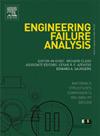The role of dynamic normal disturbances on shear properties and failure behaviours of bolt anchorage systems
IF 5.7
2区 工程技术
Q1 ENGINEERING, MECHANICAL
引用次数: 0
Abstract
This study investigates the mechanical properties and damage mechanisms of bolt-resin-rock anchorage systems subjected to shear under dynamic normal disturbances. The effects of initial normal load Fnd, cyclic normal amplitude fa, cyclic normal frequency f, and shear rate v on the shear load, normal displacement, wear characteristics and strain evolution are analysed. The test results show that the peak shear load decreases by 7.82 % ∼ 28.95 % with increasing fa, whereas it increases linearly by 15.77 % ∼ 79.85 % with Fnd. The load bearing capacity of the anchorage system is significantly weakened with increasing f, but is not sensitive to the changes of v. The system undergoes shear-induced consolidation and exhibits normal shear contraction during the initial shearing stage. As shearing progresses, the developing penetration plane enhances the climbing effect, leading to pronounced normal dilation. The resin-rock interface is more prone to debonding failure under intensified normal disturbances, whereas the shear penetration surface forms at the bolt-resin interface under high-frequency but low-amplitude normal disturbances. The force chain evolution characteristics of the anchorage system under dynamic normal disturbances from a mesoscopic perspective are analysed via the particle flow numerical simulation method from 3D point, including interface shear force distribution, cracks propagation patterns, and debonding failure mechanisms.
动态法向扰动对锚杆锚固体系剪切性能和破坏行为的影响
研究了动力法向扰动下锚杆-树脂-岩石锚固体系在剪切作用下的力学性能及损伤机理。分析了初始法向载荷Fnd、循环法向幅值fa、循环法向频率f和剪切速率v对剪切载荷、法向位移、磨损特性和应变演化的影响。试验结果表明,峰值剪切荷载随fa的增大而减小7.82% ~ 28.95%,随Fnd的增大而线性增大15.77% ~ 79.85%。锚固体系的承载能力随着f的增大而明显减弱,但对v的变化不敏感,在初始剪切阶段锚固体系发生剪切固结,并表现为正常的剪切收缩。随着剪切的进行,发展中的侵彻面增强了攀爬效应,导致明显的正向扩张。在强法向扰动下,树脂-岩石界面更容易发生脱粘破坏,而在高频低振幅法向扰动下,螺栓-树脂界面形成剪切穿透面。采用颗粒流数值模拟方法,从三维角度从细观角度分析了动态法向扰动下锚固体系的力链演化特征,包括界面剪切力分布、裂纹扩展模式和脱粘破坏机制。
本文章由计算机程序翻译,如有差异,请以英文原文为准。
求助全文
约1分钟内获得全文
求助全文
来源期刊

Engineering Failure Analysis
工程技术-材料科学:表征与测试
CiteScore
7.70
自引率
20.00%
发文量
956
审稿时长
47 days
期刊介绍:
Engineering Failure Analysis publishes research papers describing the analysis of engineering failures and related studies.
Papers relating to the structure, properties and behaviour of engineering materials are encouraged, particularly those which also involve the detailed application of materials parameters to problems in engineering structures, components and design. In addition to the area of materials engineering, the interacting fields of mechanical, manufacturing, aeronautical, civil, chemical, corrosion and design engineering are considered relevant. Activity should be directed at analysing engineering failures and carrying out research to help reduce the incidences of failures and to extend the operating horizons of engineering materials.
Emphasis is placed on the mechanical properties of materials and their behaviour when influenced by structure, process and environment. Metallic, polymeric, ceramic and natural materials are all included and the application of these materials to real engineering situations should be emphasised. The use of a case-study based approach is also encouraged.
Engineering Failure Analysis provides essential reference material and critical feedback into the design process thereby contributing to the prevention of engineering failures in the future. All submissions will be subject to peer review from leading experts in the field.
 求助内容:
求助内容: 应助结果提醒方式:
应助结果提醒方式:


